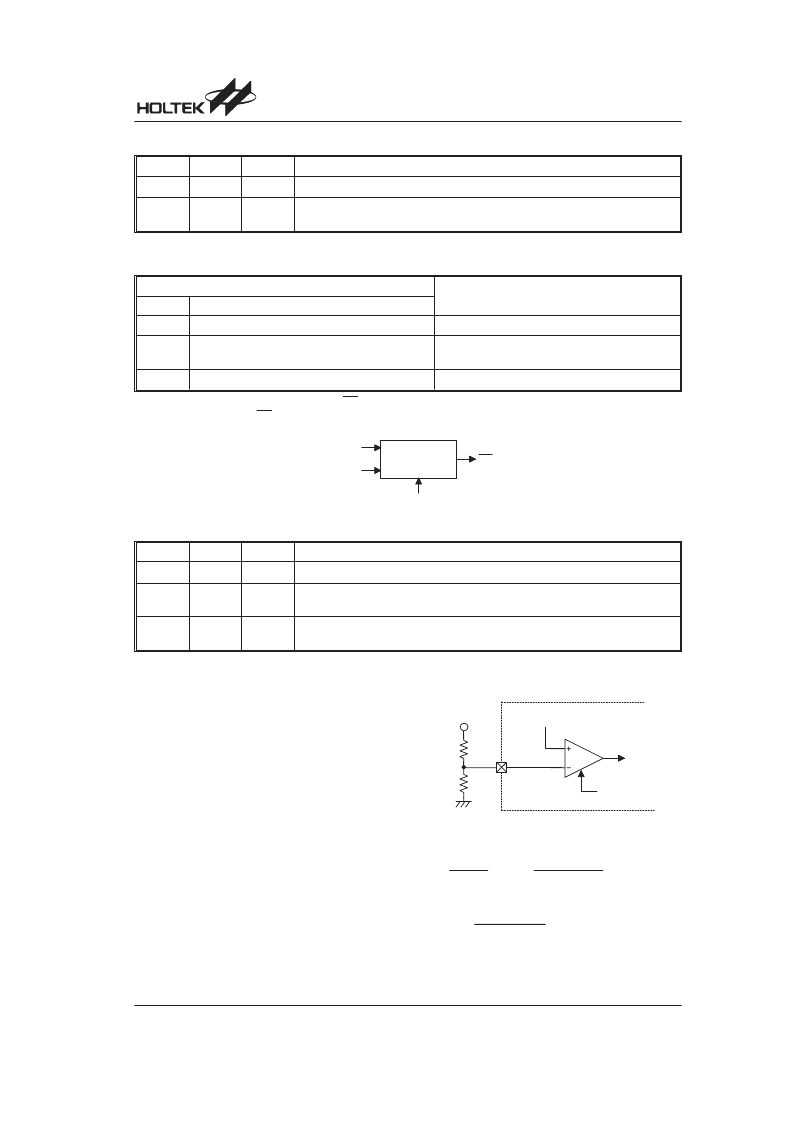- 您現(xiàn)在的位置:買賣IC網(wǎng) > PDF目錄385408 > HT95CXXX (Holtek Semiconductor Inc.) CID Type Phone 8-Bit MCU PDF資料下載
參數(shù)資料
| 型號: | HT95CXXX |
| 廠商: | Holtek Semiconductor Inc. |
| 英文描述: | CID Type Phone 8-Bit MCU |
| 中文描述: | 刑事偵緝式電話8位微控制器 |
| 文件頁數(shù): | 30/51頁 |
| 文件大小: | 384K |
| 代理商: | HT95CXXX |
第1頁第2頁第3頁第4頁第5頁第6頁第7頁第8頁第9頁第10頁第11頁第12頁第13頁第14頁第15頁第16頁第17頁第18頁第19頁第20頁第21頁第22頁第23頁第24頁第25頁第26頁第27頁第28頁第29頁當(dāng)前第30頁第31頁第32頁第33頁第34頁第35頁第36頁第37頁第38頁第39頁第40頁第41頁第42頁第43頁第44頁第45頁第46頁第47頁第48頁第49頁第50頁第51頁

HT95CXXX
Rev. 1.50
30
May 26, 2005
Line Control Function
Bit No.
Label
R/W
Function
6~0
RO
Unused bit, read as 0
7
LINEC
RW
1: Enable the line control function
0: Disable the line control function
LINE (22H) Register
The line control function is enabled by the flag LINEC
Conditions
Source to Enable
Line Control Function
LINEC
Operation Mode
1
Normal or Green mode
RTC time out interrupt
1
Sleep mode
Port A wake-up
RTC time out interrupt
1
Idle mode
Port A wake-up
Whenthelinecontrolsourceisactivated,thePOpinwillbesettohighsignal.ClearingLINECto0willterminatetheline
control function and drive PO pin outputs low signal.
RTC Function
Bit No.
Label
R/W
Function
6, 4~0
RO
Unused bit, read as 0
5
RTCEN
RW
1: Enable RTC function
0: Disable RTC function
7
RTCTO
RW
1: RTC time-out occurs
0: RTC time-out not occurs
RTCC (24H) Register
)
*
*
+ '
,
*
%
' -
!
&
( ' - # '
+
) %
*
The real time clock (RTC) is used to supply a regular in-
ternal interrupt. Its time-out period is 1000ms. If the RTC
time-out occurs, the interrupt request flag RTCF and the
RTCTO flag will be set to 1. The interrupt vector for the
RTC is 14H. When the interrupt subroutine is serviced,
the interrupt request flag (RTCF) will be cleared to 0, but
the flag RTCTO remain in its original value. If the
RTCTO flag is not cleared, next RTC time-out interrupt
will occur.
Low Battery Detection
The phone controller provides a circuit that detects the
LBIN pin voltage level. To enable this detection func-
tion, the LBEN should be written as 1. Once this function
is enabled, the detection circuit needs 50 s to be stable.
After that, the user could read the result from LBFG. The
low battery detect function will consume power. For
power saving, write 0 to LBEN if the low battery detec-
tion function is unnecessary.
) . %
) . # /
" 0
,
+
) .
,
,
The battery low threshold is determined by external R1
and R2 resistors.
1.15=V
xR2
+
R1
R2
DET
V
DET
=1.15x(R1+R2)
R2
If we want to detect V
DET
=2.4V
then 2.4V=1.15x(R1
R2)
R2
+
R1=1.087R2
相關(guān)PDF資料 |
PDF描述 |
|---|---|
| HT95L400-128QFP-A | LCD Type Phone 8-Bit MCU |
| HT95L100-64QEP-A | LCD Type Phone 8-Bit MCU |
| HT95L10P-64QEP-A | LCD Type Phone 8-Bit MCU |
| HT95L100-64QFP-A | 8-Bit LCD Type Phone Controller MCU |
| HT95L10P-64QFP-A | 8-Bit LCD Type Phone Controller MCU |
相關(guān)代理商/技術(shù)參數(shù) |
參數(shù)描述 |
|---|---|
| HT95L000 | 制造商:HOLTEK 制造商全稱:Holtek Semiconductor Inc 功能描述:CID Type Phone 8-Bit MCU |
| HT95L000-56SSOP-A | 制造商:HOLTEK 制造商全稱:Holtek Semiconductor Inc 功能描述:LCD Type Phone 8-Bit MCU |
| HT95L00P | 制造商:HOLTEK 制造商全稱:Holtek Semiconductor Inc 功能描述:LCD Type Phone 8-Bit MCU |
| HT95L00P-56SSOP-A | 制造商:HOLTEK 制造商全稱:Holtek Semiconductor Inc 功能描述:LCD Type Phone 8-Bit MCU |
| HT95L100 | 制造商:HOLTEK 制造商全稱:Holtek Semiconductor Inc 功能描述:CID Type Phone 8-Bit MCU |
發(fā)布緊急采購,3分鐘左右您將得到回復(fù)。